Glossary

Amplexus
Aestivate – see Estivate
Amplexus – the mating position of frogs and toads in which the male clasps the female about the back.
Anterior – referring to the front or head-end.
Anthropogenic – literally ‘human-created’. When used to describe habitats, the term refers to environments that are predominantly human-made, and usually associated with regular human presence – such as urban areas, parks, gardens, and agricultural land.
Anthropogenic disturbance – can refer to any form of habitat modification with a human cause, such as forestry, or secondary growth following land clearance, or marsh drainage for agricultural activities.
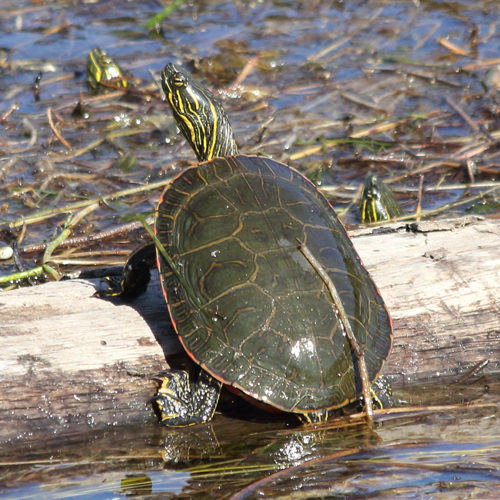
Carapace
Autotomy – (caudal autotomy) the ability to shed part or all of the tail as a defensive mechanism. Nervous impulses in the tail cause it to twitch for some time, distracting potential predators long enough to allow the animal to escape. The severed tail will regrow, but the regenerated tails are generally shorter, less colourful, and more brittle than the original tail. Most common among lizards and salamanders.
Carapace – the hard upper shell of a turtle, crustacean, or arachnid.
Caudal – referring to the rear or tail-end.
Cloaca – the common cavity into which the intestinal, urinary, and reproductive canals open in birds, reptiles, amphibians, many fishes, and certain mammals. The cloaca is often referred to simply as the vent.
Carapace – the hard upper shell of a turtle, crustacean, or arachnid.
Caudal – referring to the rear or tail-end.
Cloaca – the common cavity into which the intestinal, urinary, and reproductive canals open in birds, reptiles, amphibians, many fishes, and certain mammals. The cloaca is often referred to simply as the vent.
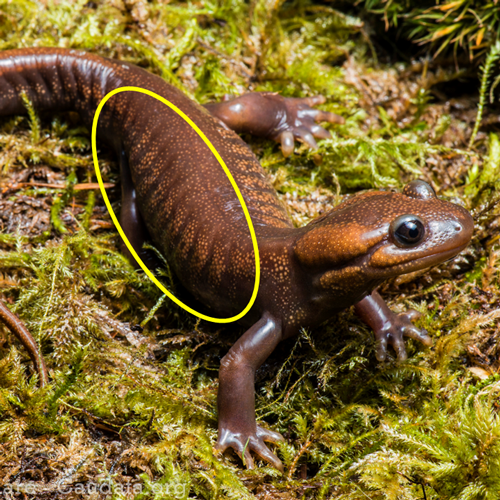
Costal Groove
Costal Groove – grooves along the sides of a salamander’s body that increase the surface area of the skin and creates channels for water to flow and collect on their body. This is important to prevent their skin from drying out. The number of costal grooves can often be used to help identify the species.
Crepuscular – active around dawn and/or dusk.
Crypsis – used to describe an animal in relation to its surroundings, a cryptic species blends in well with its background due to camouflage or dull colouration.
Dorsal – relating to the top or back.
Crepuscular – active around dawn and/or dusk.
Crypsis – used to describe an animal in relation to its surroundings, a cryptic species blends in well with its background due to camouflage or dull colouration.
Dorsal – relating to the top or back.

Dorsolateral Folds
Dorsolateral Folds – visible raised ridges of skin that run down part of all of the length of the back, usually on the sides. Can often be used as an identifying feature in many frogs and some toads.
Ecdysis – the process of shedding the dead outer skin in reptiles.
Estivate – to spend a hot, dry season in an inactive, dormant state. Particularly in certain reptiles, snails, insects, and small mammals. Also aestivate.
Fossorial – used to describe a species adapted to living underground. Most commonly refers to species that burrow into or live beneath or within leaf litter, sand, mud, or other surface cover.
Gular – referring to the throat.
Ecdysis – the process of shedding the dead outer skin in reptiles.
Estivate – to spend a hot, dry season in an inactive, dormant state. Particularly in certain reptiles, snails, insects, and small mammals. Also aestivate.
Fossorial – used to describe a species adapted to living underground. Most commonly refers to species that burrow into or live beneath or within leaf litter, sand, mud, or other surface cover.
Gular – referring to the throat.
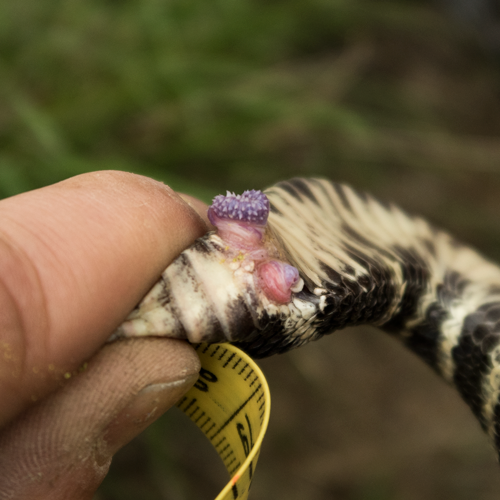
Hemipenes
Hemipenes – the term for dual penises found in male lizards and snakes. When not actively mating, the hemipenes are contained within the body.
Herpetology – the study of reptiles and amphibians
Hibernaculum – winter dwelling of a hibernating animal. Plural hibernacula.
Hibernation – term to describe a period of dormancy in animals, usually as a response to low external temperatures during which most metabolic processes are slowed, including respiration and thermoregulations. In true hibernation, the animal is dormant the entire period, without emerging to feed. However, the term is often broadly used to describe any form of overwinter dormancy.
Keeled Scales – refers to scales that contain a ridge down the centre that may or may not extend to the tip of the scale. Scales that are keeled are rough to touch. Western Rattlesnakes, for example, have heavily keeled scales.
Herpetology – the study of reptiles and amphibians
Hibernaculum – winter dwelling of a hibernating animal. Plural hibernacula.
Hibernation – term to describe a period of dormancy in animals, usually as a response to low external temperatures during which most metabolic processes are slowed, including respiration and thermoregulations. In true hibernation, the animal is dormant the entire period, without emerging to feed. However, the term is often broadly used to describe any form of overwinter dormancy.
Keeled Scales – refers to scales that contain a ridge down the centre that may or may not extend to the tip of the scale. Scales that are keeled are rough to touch. Western Rattlesnakes, for example, have heavily keeled scales.
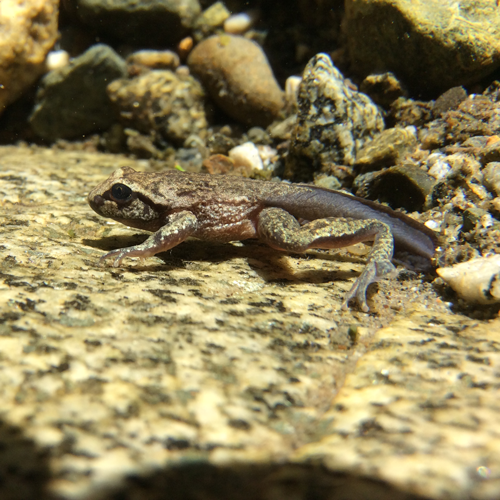
Metamorph
Labial – referring to the lips, such as a marking along the lip.
Lateral – relating to the sides or flanks.
Mark-Recapture – a common method in ecology to estimate an animal population’s size when it is impractical to count every individual. A portion of the population is captured, marked in some fashion, and released. Later, another portion of the population is captured. A mathematical equation estimates the population size based on how many previously marked individuals were recaptured.
Metamorph – a newly metamorphosed frog, may not be fully transformed into the adult form yet.
Lateral – relating to the sides or flanks.
Mark-Recapture – a common method in ecology to estimate an animal population’s size when it is impractical to count every individual. A portion of the population is captured, marked in some fashion, and released. Later, another portion of the population is captured. A mathematical equation estimates the population size based on how many previously marked individuals were recaptured.
Metamorph – a newly metamorphosed frog, may not be fully transformed into the adult form yet.

Nasolabial Groove
Metamorphosis – the transition from a larva to adult in amphibians.
Microhabitat – within a broad habitat type (such as a forest), microhabitat defines particular elements of that habitat’s structure an climate upon which species depend, such as favourite shelter type (tree, rocky streambed, leaf litter, etc.) moisture regimes, breeding or foreign sites.
Nasolabial Groove – small grooves that extend from the upper lip to the nostril in lungless salamanders. The salamander smells by touching its snout to a surface (nose tapping), allowing odour particles travel up the groove into sensory cells in the nose
Microhabitat – within a broad habitat type (such as a forest), microhabitat defines particular elements of that habitat’s structure an climate upon which species depend, such as favourite shelter type (tree, rocky streambed, leaf litter, etc.) moisture regimes, breeding or foreign sites.
Nasolabial Groove – small grooves that extend from the upper lip to the nostril in lungless salamanders. The salamander smells by touching its snout to a surface (nose tapping), allowing odour particles travel up the groove into sensory cells in the nose
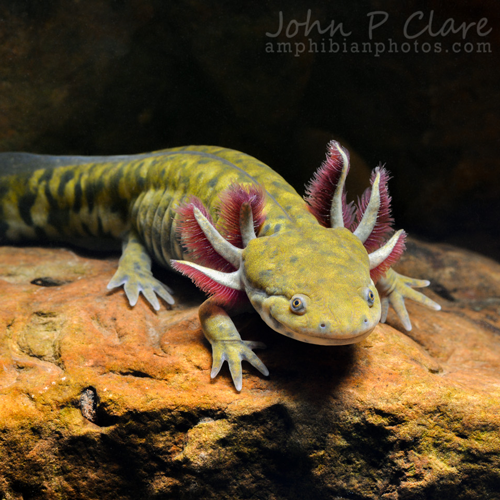
Neoteny
Neoteny – The retention of juvenile characteristics in an adult. In amphibians, particularly amongst salamanders, neotenic individuals mature to a reproductive stage without fully undergoing the process of metamorphosis from aquatic larva to land-based adult. These individuals typically do not lose their gills, tail fins, larval colouration, and wide heads.
Nuchal – relating to the neck.
Nuptial Pads – thickened, often hardened, pads on the fingers of many adult frogs used to clasp females while breeding. Nuptial pads may be present year-round or may develop only during the breeding season.
Nuchal – relating to the neck.
Nuptial Pads – thickened, often hardened, pads on the fingers of many adult frogs used to clasp females while breeding. Nuptial pads may be present year-round or may develop only during the breeding season.
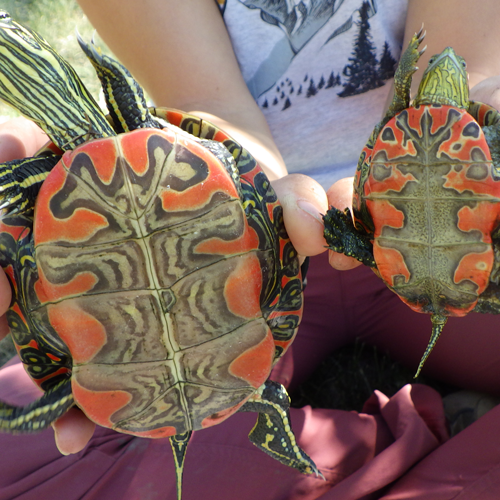
Plastron
Plastron – the nearly flat part of the shell structure on the underside of a turtle or other animal.
Rostral – relating to the snout (rostrum).
Scale – body covering composed of keratin arranged as numerous adjoining plates. The shape, arrangement, and number of scales is important for distinguishing reptile species.
Scutes – individual plates of the carapace in turtles. Also often used for belly scales of snakes.
Rostral – relating to the snout (rostrum).
Scale – body covering composed of keratin arranged as numerous adjoining plates. The shape, arrangement, and number of scales is important for distinguishing reptile species.
Scutes – individual plates of the carapace in turtles. Also often used for belly scales of snakes.
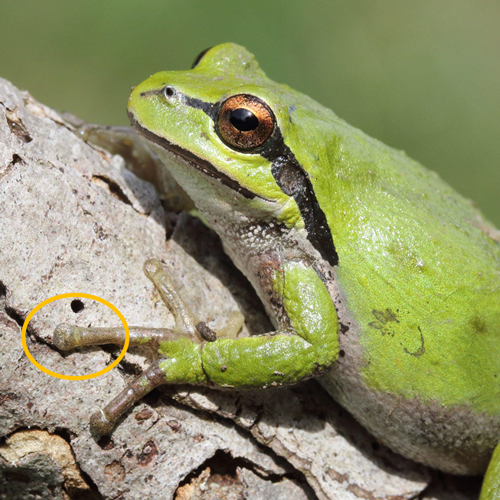
Toe Pads
Snout-Vent Length (SVL) – In reptiles, the most common measurement of body size, taken from the tip of the snout to the cloacal opening (vent), i.e. the length of the body excluding the tail. May also be used to measure amphibians and tadpoles.
Thermoregulation – the act of maintaining body temperature at a level that allows for continued activity. Most reptiles and amphibians rely on behaviours, such as basking in sunlight and retreating to shade in warm periods, to regulate their body temperature.
Toe Pads – enlarged disc-shaped swellings at the base of the toes and fingers in many groups of frogs. The presence and size of toe pads generally indicates an adaption for a climbing lifestyle. Also referred to as toe discs.
Thermoregulation – the act of maintaining body temperature at a level that allows for continued activity. Most reptiles and amphibians rely on behaviours, such as basking in sunlight and retreating to shade in warm periods, to regulate their body temperature.
Toe Pads – enlarged disc-shaped swellings at the base of the toes and fingers in many groups of frogs. The presence and size of toe pads generally indicates an adaption for a climbing lifestyle. Also referred to as toe discs.

Tympanum
Tubercle – a round nodule, eminence, or warty outgrowth that can be found on any part of the body, often giving a pebbly or prickly texture to the skin.
Tympanum – the ear opening in many amphibians, reptiles, and insects. In amphibians, it is normally covered by a circular membrane. The relative size of the tympanum can sometimes help distinguish between species and between males and females of the same species.
Ventral – relating to the bottom or underside.
Tympanum – the ear opening in many amphibians, reptiles, and insects. In amphibians, it is normally covered by a circular membrane. The relative size of the tympanum can sometimes help distinguish between species and between males and females of the same species.
Ventral – relating to the bottom or underside.

Vocal Sac
Viviparity – a reproductive strategy where the mothers both give birth to live young, and provide nourishment for offspring as they develop in the mother’s womb. Sometimes referred to as ‘live-bearing’.
Vocal Sac – the calling apparatus in most male frogs, consisting of a pouch beneath the chin or, less commonly, two pouches, which can be inflated with air from the lungs.
Vocal Sac – the calling apparatus in most male frogs, consisting of a pouch beneath the chin or, less commonly, two pouches, which can be inflated with air from the lungs.
